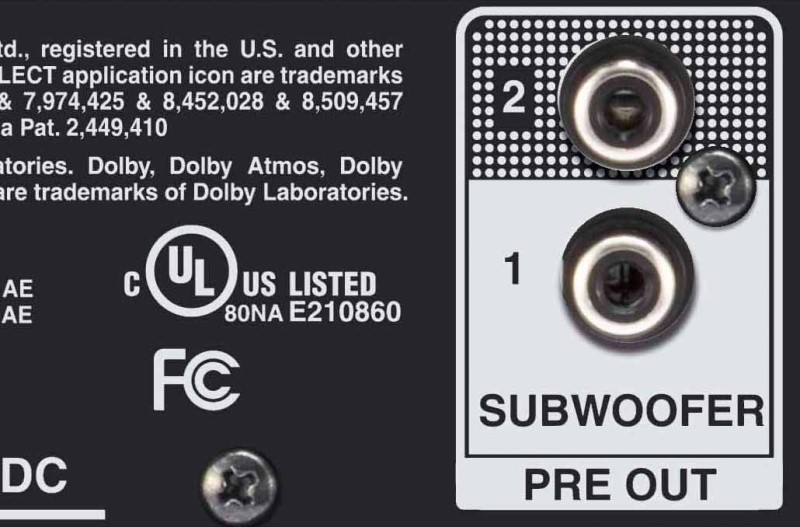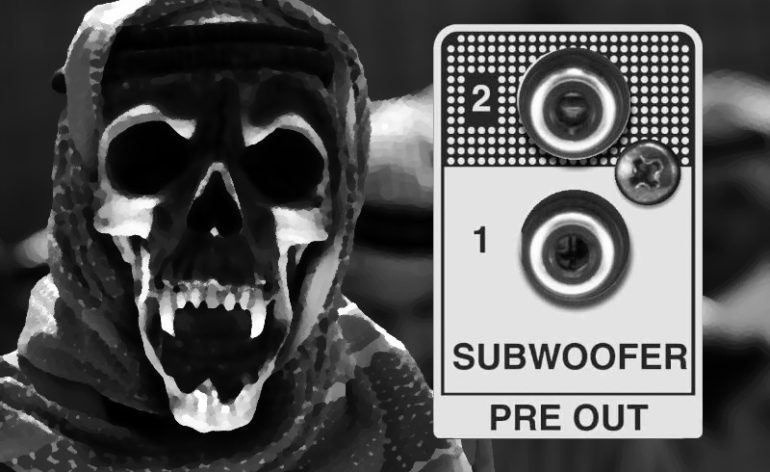Discrete Subwoofer Outputs on AV Receivers are Evil
One of the problems with running two subwoofers is calibration. If you follow our calibration guide, you’ll find that we are really only using one subwoofer output. There is a reason for that. The two subwoofers may be two different boxes, but they work together to make the bass that you experience in your room. That may seem counterintuitive. It is exactly that counterintuitiveness that makes discrete subwoofer outputs on AV receivers so evil.
What Do We Mean by Discrete Subwoofer Outputs
In most modern AV receivers, there are two (or sometimes more) available subwoofer outputs. These allow you to connect to two different subwoofers. It also allows the AV receiver to set the distance and trim levels (volume) of each subwoofer separately. That’s great. We love it.
That is not the problem.
A discrete output means that each subwoofer is treated as its own entity. For the purpose of setting the levels and distance, that’s fine (though it is generally better to set all the distances to the same but that’s a topic for a different article). Discrete subwoofer outputs become evil when AV receivers move on to the calibration stage. See, subwoofers may be in different boxes, but they are part of the same system.
If you look at your speakers, they often have more than one driver. They are in the same enclosure and they work together to create the sound you hear. In fact, if you were to break open the side of a speaker, you may find that some of the drivers are physically isolated from the others. This often happens with the tweeter and/or midrange drivers. They will be isolated (in their own enclosure) from the bass drivers. If you see two ports on the back of a speaker, it is likely because there are two different enclosures in the cabinet that both need to be vented.

Why Are Discrete Subwoofers a Bad Thing?
Discrete outputs mean that each subwoofer can be fed different signals. The two-channel crowd, and those that didn’t really understand how bass works, demanded this. They thought that each subwoofer should be placed near their front speakers and be fed the bass that the front speaker nearest would get. It makes intuitive sense that each subwoofer might be calibrated separately. They are in different places in the room. We calibrate our other speakers separately, don’t we? Shouldn’t subwoofers be the same?
Unfortunately, no.
When we calibrate subwoofers, they should be treated as one. No matter how many you have. This is because the subwoofers interact with each other and the room to create the bass you experience. We’ll leave the heavy lifting on this topic to Dr. Toole et. al. but the short version is that to get the most even bass in your room, you need an even number of subwoofers and to have them placed optimally. They also need to be fed the same signal.
The exact same signal.
My Subwoofers, My Choice
Listen, I don’t care how you set up or calibrate your speakers or subwoofers. It is your system, if you like it, who am I to say otherwise? But it rarely stops there. If you like your system, you can’t help but tell others to do the same. And to get the best bass, both subwoofers should be treated as a single “bass system” in your room. The research has shown this to be true and many, many people have discovered it as well.
The problem is AV receiver manufacturers. They’ve listened to the masses and given them what they want. They wanted their subwoofers to be calibrated separately, so they’ve included that ability. But they forgot one thing. They forgot to include the menu option to treat both subwoofers as one during the calibration process.
Most AV receivers will allow you to use their discrete subwoofer outputs as a stereo pair up front, split front and back, and other options. What they will not allow, is for you to treat both subs as one. And that’s the problem. By going from a single, mono subwoofer output to dual discrete outputs, AV receivers have lost the ability to select a mono option for the calibration process.
Conclusion
Our dual subwoofer calibration guide gives you the workaround that will allow you to treat your dual subwoofers as one during calibration. But it requires you to use a single subwoofer output and buy a Y-splitter. That shouldn’t be necessary. You should be able to select “mono” in the menus and have the receiver do it automatically. You should have an option that allows you to get the best, most even, bass two subwoofers can provide. But that option was discarded when manufacturers started offering that second subwoofer output. While discrete subwoofer outputs in AV receivers aren’t inherently evil, they aren’t being used for good. And isn’t that enough?



I’m a little confused by this article. I’m most familiar with Audyssey which as you know is one of the more popular room correction systems. The lower end flavors just have dual sub outs with an internal y splitter so they are effectively one channel. The higher end flavor, XT32, has 2 discrete sub outs. While it does set delay and level separately for each sub it does indeed then calibrate the subs as one channel. I do know some feel that they get slightly better results using a single sub out and manually calibrating in some scenarios but Audyssey nonetheless is treating the subs as one in terms of filters applied. You can also hear when running calibration that it pings both subs separately for the first run to set delay/level but all subsequent pings are both subs together.
Jason – You are correct. The lower-end receivers sometimes do have an internal Y-splitter. This is what we’d prefer. But the higher-end Audyssey solutions don’t. You cannot select, in the higher-end solutions, to run the subs as mono. They both get discrete calibration which is not what works best. I had a section in here talking about the fact that the lower-end receivers actually do it better but I took it out as I felt it made things more confusing. Also, Denon and Audyssey don’t exactly brag about their lower-end versions having internal Y-splitters so it is sometimes very hard to figure out how they do it. I assumed that someone would mention it in the comments and we could talk about it here. So, thanks for helping me out! We just want all the room correction programs (including DIRAC and YPAO) to provide a mono option. Currently, that isn’t the case.
Thanks. So even though Audyssey XT32 sets levels/delays separately but applies one set of filters for both subs (treating them as one sub) you feel this is still inferior? It seems that in the 12 step calibration guide you guys have on AV rant (love the podcast buy the way) you are doing effectively the same thing but using phase adjustment instead of setting separate delays.
Thanks for the explanation!!! I am deciding on an anthem mrx 540 or denon 3700 and liking the anthem more but its two subs ports are parallel so I thought that was inferior to the dual independent sub ports on the denon.